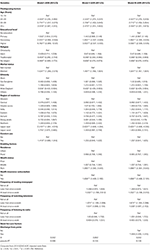


I have found a pretty solution for it, but it is not very easy to implement. I may write a post on how to align columns of tex tables later. You can learn about all of Stata and about all of Statas features. Read about all the new features in Stata 14 below. Please see our Stata 17 page for the new features in Stata 17. This code should give you the following table. This page announced the new features in Stata 14. So, if you want to include the F-statistic in your latex table using esttab, save the correspondent entry of the matrix as a scalar and add it to your table using the “stats()” option.Įsttab a using table1.tex, collabels(none) cells(b(star fmt(3) vacant(\)"' `"\(F\)"')) drop(_cons) Stata stores the information displayed in this table in a matrix called “r(singleresults)” - it is in the return list. The new Bayesian analysis features introduced in Stata 14 now have dramatically improved performance and capabilities when working with latent variables. Here are some of the treats in Stata 14.1. Just type update query and follow the instructions. Qui ivregress 2sls rent pcturban (hsngval = faminc)įirst-stage regression summary statistics If you are using Stata’s “ivregress” command, you can obtain this statistic by typing “estat firststage”. The rule of thumb is that a first-stage F-statistic of above 10 indicates that your instruments are relevant enough so that the finite-sample IV estimate is not biased towards the OLS one.The F-statistic that this rule refers to is the one calculated for the excluded instruments only, not the one reported in the first-stage including all regressors.


 0 kommentar(er)
0 kommentar(er)
